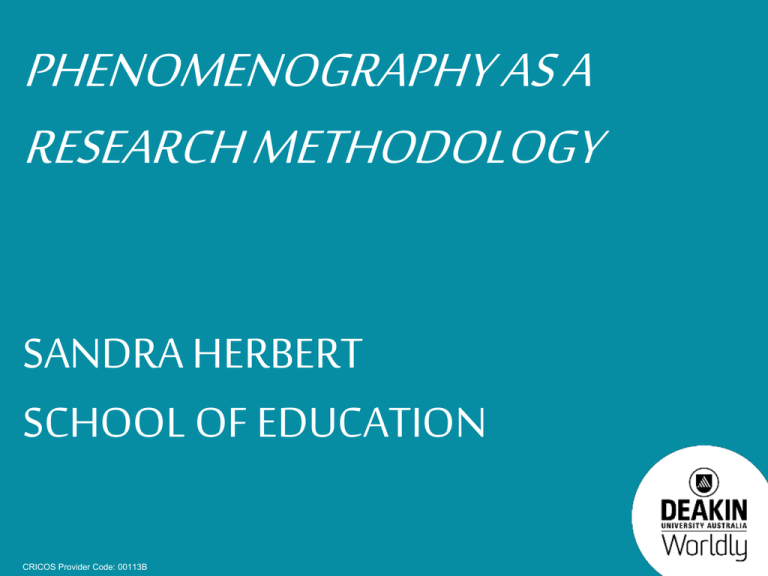Phenomenography as a Research Methodology – by Sandra Herbert
advertisement

PHENOMENOGRAPHY AS A RESEARCH METHODOLOGY SANDRA HERBERT SCHOOL OF EDUCATION CRICOS Provider Code: 00113B THIS PRESENTATION • phenomenography • conceptions of rate as an example • data collection • analysis → categories → outcome space • Discussion • Other example if time permits 2 CRICOS Provider Code: 00113B PHENOMENOGRAPHY Research method adapted for mapping the qualitatively different ways in which people experience, conceptualise, perceive, and understand various aspects of, and phenomena in, the world around them (Marton, 1986, p. 31) • aims to: reveal categories of description delineated by dimensions of variation emerging from data & hence, structuring categories into outcome space CRICOS Provider Code: 00113B WHY PHENOMENOGRAPHY? • demonstrated efficacy in a range of educational research including mathematics. • focus on ideas expressed by the group of participants. –attempts to describe phenomenon as seen by participants. • variation in conceptions is expected. • identify variation (categories of description). –diversity of students → range of variation –structure categories into an outcome space CRICOS Provider Code: 00113B OUTCOME SPACE • structured set of categories of description • one category likely to display “correct meaning, correct knowledge or correct understanding” (Webb, 1996) –as accepted by community of practice • other categories display less complete understanding • individual may hold >1 conception. • outcome space considered to be final result of phenomenographic investigation (Marton,1988). CRICOS Provider Code: 00113B ANALYSIS • each data source considered several times • categories of description –groupings of meaning statements • dimensions of variation –themes of expanding awareness • emerged from data over many iterations • categories delineated in terms of dimensions 6 CRICOS Provider Code: 00113B OVERVIEW OF PHENOMENOGRAPHIC STUDY CRICOS Provider Code: 00113B THIS PHENOMENOGRAPHIC STUDY •Investigating conceptions of rate • Selection of sample: – aim for maximum variation; – 20 diverse Year 10 students. • Conduct interviews: – phenomenographic video-recorded semi-structured interviews – based on computer simulations, enabling exploration of constant & variable rate in multiple representations • Phenomenographic analysis of responses to reveal students’ conceptions CRICOS Provider Code: 00113B DATA COLLECTION 9 CRICOS Provider Code: 00113B Consistent presentation to ensure attention to same phenomenon PHENOMENOGRAPHIC ANALYSIS OF THIS STUDY • immersion in data. –each video repeatedly viewed. –gestures used to give insights into meaning of words • pooling & grouping of meaningful responses from data into meaning statements. • grouping of meaning statements into initial categories. • formation of initial dimensions • final dimensions & categories developed over many iterations. • categories structured into outcome space. – based on dimensions – probably hierarchical. –some categories more complex & complete. CRICOS Provider Code: 00113B EVOLUTION OF CATEGORIES & DIMENSIONS • interviews transcribed –checked against audio & video • immersion in data • interpret gist of participants’ verbal & non-verbal communications • set of meaning statements 11 CRICOS Provider Code: 00113B Transcript it goes up three point two meters every half a meter Interpretation • suggests understanding of rate involving constant change in one variable wrt unit change of another variable. 12 CRICOS Provider Code: 00113B Transcript R: what do you think the graph [of non-rectangle window] might look like? [long pause] S: I don’t think it would be a straight line [pause] because this window’s not square hmm I dunno because its up the top umm curved there [pause] umm a straight line means its always the same R: what’s always the same? S: the umm Interpretation of Gestures • identified key differences in rate for the window • gestures communicate awareness that graph of curved section not the same rectangular section. • constant rate results in linear graph CRICOS Provider Code: 00113B MEANING STATEMENTS 1. 2. 3. 4. 5. 6. 7. 8. 9. 10. 11. 12. 13. 14. 15. 16. 17. 18. Students see rate, which may vary, as a quantitative relationship between two quantities which may vary. Students see rate, which may vary, as a qualitative relationship between two quantities which may vary. Students see rate as a single number measuring a constant relationship between two quantities which may vary. Students see rate as a two numbers representing a constant relationship between two quantities which may vary. Students see rate as a constant relationship between two quantities. Students see rate as a comparison between two quantities. Students see rate as a relationship between two quantities. Students see rate as something to do with change. Students see rate as speed. Students see rate as something to do with time. Students see rate as something to do with fractions. Students see rate as an amount. Students see rate as the result of a formula calculation. Students see rate as a single number measuring something at a particular stage. Students see rate as a word they’ve heard eg. birth rate, interest rate Students see rate as nothing at all. Students see rate as something to do with maths Students see rate as something to do with two quantities CRICOS Provider Code: 00113B 16. 15. 11. 17. 12. 13. 14. Students see rate as nothing at all. Students see rate as a word they’ve heard eg. birth rate, interest rate, council rates. Students see rate as something to do with fractions. Students see rate as something to do with maths 8. Students see rate as an amount. Students see rate as the result of a formula calculation. Students see rate as a single number measuring something at a particular stage. Students see rate as something to do with change. 9. 10. Students see rate as speed. Students see rate as something to do with time. 6. 18. 7. Students see rate as a comparison between two quantities. Students see rate as something to do with two quantities Students see rate as a relationship between two quantities. 5. Students see rate as a constant relationship between two quantities. Students see rate as a two numbers representing a constant relationship between two quantities which may vary. Students see rate as a single number measuring a constant relationship between two quantities which may vary. 4. 3. 2. 1. Students see rate, which may vary, as a qualitative relationship between two quantities which may vary. Students see rate, which may vary, as a quantitative relationship between two quantities which may vary. CRICOS Provider Code: 00113B GROUPING OF MEANING STATEMENTS CATEGORIES VERSION 1 • 5 categories & 3 dimensions • categories of description 1. 2. 3. 4. 5. Rate is seen as abstract concept that can be applied to variety of contexts ( with subcategories or >1 category?) Rate is seen as something to do with motion. Rate is seen as something to do with time but not motion OR is this motion but not time? Rate is seen as a mathematical concept, but not even understood in application to motion Rate is not seen • dimensions of variation 1. 2. 3. Type of Rate: with attributes ‘constant’ & ‘variable’ Context: with attributes ‘speed’ & ‘not-speed’ Relationship: with attributes ‘qualitative’ & ‘quantitative’ CRICOS Provider Code: 00113B ITERATIVE PROCESS • consideration of structure of outcome space –least to most complex • some categories more complex & complete than others –include aspects of awareness of earlier categories • more detail in descriptions of categories –return to data –focus on how rate was experienced with less emphasis on what the participants did or said –ask “Can these be grouped?” “Are there examples of things that students say/do which illustrate this category?” 17 CRICOS Provider Code: 00113B VERSION 5 • Dimensions of Variation • another 2 dimensions added – Property attributed to rate: with attributes ‘quality’ & ‘quantity’ – Characteristics of property: with attributes ‘1-fixed’, ‘1-changing’, ‘2changing’ • labels & attributes of other dimensions changed – Context became Related variables: with attributes ‘distance&time’ & ‘any pair’ – Type of rate & Relationship were combined in ‘nature of relationship’ with attributes with attributes ‘qualitative’, ‘quantitativeconstant’& ‘quantitative-variable’ 18 CRICOS Provider Code: 00113B VERSION 5 Categories 1. 2. 3. 4. 5. 6. 7. 8. Rate is experienced as a word Rate is experienced as the result of a formula calculation Rate is experienced as a change in a quality Rate is experienced as a change in a single quantity Rate is experienced as the relationship between two changing quantities Rate is experienced as the relationship between two changing quantities of distance and time i.e. speed Rate is experienced as an unchanging numeric relationship between two changing quantities Rate is experienced as a numeric relationship between two changing quantities 19 CRICOS Provider Code: 00113B VERSION 9 Dimensions of Variation 1. 2. 3. 4. Focus on word ‘rate’ Focus on variables Focus on relationship between variables Focus on nature of related variables Categories Rate is experienced as :A. a word rating a quality B. a word associated with a numeric value C. the result of a formula calculation with little meaning D. a single quantity E. a relationship between two changing quantities F. a constant numeric relationship between two changing quantities G. a numeric relationship between two changing quantities of distance and time i.e. speed H. a numeric relationship between any two changing quantities CRICOS Provider Code: 00113B Rate experienced as a word associated with something numeric Rate experienced as formula calculation Rate experienced as a single quantity EVENTUALLY!! Rate experienced as rating of a quality Rate experienced as qualitative relationship b/w 2 changing quantities Rate experienced as constant numeric relationship b/w 2 changing quantities Rate experienced as speed Rate experienced as numeric relationship b/w any 2 changing quantities CRICOS Provider Code: 00113B RATE OUTCOME SPACE STRUCTURED BY DIMENSIONS Categories of Description Dimension Attribute Word ‘rate’ Quality Quantity Variables One - fixed One - changing Two - changing Relationship Qualitative Quantitative constant Quantitative variable Nature of Distance & time variables Any pair CRICOS Provider Code: 00113B A B C D E F G H ARTICLES UTILISING PHENOMENOGRAPHY Herbert, S. & Pierce, R. (2013). Gesture as data for a phenomenographic analysis of mathematical conceptions. International Journal of Educational Research, 60, 1 - 10. Herbert, S. & Pierce, R. (2012). Revealing educationally critical aspects of rate. Educational Studies in Mathematics. 81 (1), 85-101 Herbert, S. , Vale, C., Loong, E., Bragg, L. & Widjaja, W. (submitted). Developing a framework for primary teachers’ perceptions of Mathematical Reasoning. Educational Studies in Mathematics Herbert, S. & Lynch, J. (in progress). Teachers’ Perceptions of Classroom Animals: A Phenomenographic Study Sandra Herbert sandra.herbert@deakin.edu.au CRICOS Provider Code: 00113B OTHER EXAMPLES •Teachers’ perceptions of mathematical reasoning - ESM •Teachers’ perceptions of classroom animals – forthcoming •Teachers’ responses to AC:Science – collecting data CRICOS Provider Code: 00113B MEANING STATEMENTS Teachers see mathematical reasoning as: expressing ideas describing actions giving reasons for actions justifying actions proving discriminating between choices - selection communication to oneself - self talk evaluation of an argument not relevant to younger years making connections application of prior knowledge about learning curriculum content solving word problems an indicator of mathematical ability an important part of mathematics which needs improvement a series of logical steps CRICOS Provider Code: 00113B solving open-ended problems needing less structured lessons justifying to another person. part of every mathematics lesson metacognition language necessary to reason with inference from evidence similar to reasoning in other curriculum areas discussing with another person different from content thinking looking for patterns generalising Grouping of Meaning Statements Initial Categories CATEGORIES AND OUTCOME SPACE BASED ON DIMENSIONS Audience Self Others CRICOS Provider Code: 00113B Purpose Recount Compare/ Contrast Make choices Explain Argue step-by-step Articulate reasons Justify Hypothesise Generalise Prove Evaluate Connect Presentation Verbal Symbolic Diagram/Written Gesture (action) Type of reasoning Adaptive Inductive Deductive Inferential Structure of outcome space Dimension Attribute/Value Audience Self Others Purpose Recount Compare/Contrast Make choices Explain Argue step-by-step Articulate reasons Justify Hypothesise Generalise Prove Evaluate Connect Presentation Verbal Symbolic Diagram/written Gesture (action) Type of Adaptive Reasoning Inductive Deductive Inferential CRICOS Provider Code: 00113B Categories of Description A B C D E F G OUTCOME SPACE OF PRIMARY TEACHERS' PERCEPTIONS OF MATHEMATICAL REASONING Category Category A Category B Category C Category D Category E Category F Perception of mathematical reasoning Reasoning is perceived to be thinking. Reasoning is perceived to be communicating thinking Reasoning is perceived to be problem solving Reasoning is perceived to be validating thinking Reasoning is perceived to be forming conjectures Reasoning is perceived to be using logical arguments for validating conjectures Category G Reasoning is perceived to be connecting aspects of mathematics CRICOS Provider Code: 00113B MEANING STATEMENTS Classroom animals • • • • • • • • • • • • Classroom animals are seen to be an opportunity for science education Classroom animals are seen to be an opportunity for humane education Classroom animals are seen to be an opportunity for addressing inequity Classroom animals are seen to be an inconvenience Classroom animals are seen to be an ethical dilemma Classroom animals are seen to be a media opportunity Benefits of classroom animals are seen to be dependent on the type of animal Benefits of classroom animals are seen to be dependent on the teacher Classroom animals are seen to involve a cost (emotional cost, time cost, financial cost, space costs) Classroom animals are seen as an opportunity for student social-emotional development Classroom animals are seen an opportunity for cross-curricular learning and enquiry learning Classroom animals are seen an opportunity for connections (between home and school; in-class and out-of-class; and classroom and yard/other physical spaces/locations) CRICOS Provider Code: 00113B DIMENSIONS Curriculum Social/emotional Cost Connections science responding to disadvantage ethical inconvenience financial wider community home personal development motivation space out of class emotional cross curricula humane other CRICOS Provider Code: 00113B OUTCOME SPACE OF PRIMARY TEACHERS' PERCEPTIONS OF CLASSROOM ANIMALS Category Perception of classroom animals Category A Classroom animals are perceived to be valuable for science education. Classroom animals are perceived to be valuable for humane education. Classroom animals are perceived as an opportunity for cross curriculum learning Classroom animals are perceived to be an added burden in the classroom Classroom animals are perceived to provide opportunities for links to outside the classroom Category B Category C Category D Category E CRICOS Provider Code: 00113B CRICOS Provider Code: 00113B Example: Lee and Gerber (1999) a study of Hong Kong school students’ perceptions of graphs, charts and maps Outcome space consists of a set of 5 categories of description Category 1 Graphics are seen as ordinary drawings Category 2 Graphics are seen as partially interpreted macro representations Category 3 Graphics are seen as portraying localised patterns Category 4 Graphics are seen as representing spatial relationships Category 5 Graphics are seen as providing the basis for reflection, extrapolation and prediction Ordering of categories from least to most complex Learning – moving from a category to higher category CRICOS Provider Code: 00113B EXAMPLE: COPE (2002) A STUDY OF IT STUDENTS’ CONCEPTIONS OF INFORMATION SYSTEMS OUTCOME SPACE CONSISTS OF A SET OF 6 CATEGORIES OF DESCRIPTION ORDERED FROM MOST TO LEAST COMPLEX Category 6 A number of communicating information systems within a single organisation Category 5 A computerised data manipulation system and all the people and the data-related procedures they perform to support a single organisational function. Category 4 A computerised data manipulation system supporting many people within a single organisational function. Category 3 A data manipulation system supporting an individual within a single organisational function. Category 2 A simple information retrieval system. Category 1 A personal search of a static information source CRICOS Provider Code: 00113B SIMULATIONS WITH GSP • enable exploration of constant & variable rate in multiple representations CRICOS Provider Code: 00113B GEOMETERS’ SKETCHPAD 36 CRICOS Provider Code: 00113B 37 CRICOS Provider Code: 00113B SIMULATIONS WITH JMW 38 CRICOS Provider Code: 00113B


![e-Exemption, Application for []](http://s3.studylib.net/store/data/008785386_1-026ce651779c9693dde4b1ba9583a68c-300x300.png)


